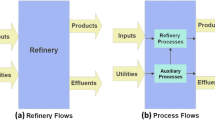Abstract
Unstable market systems and consumer preferences for virgin oil have inhibited the development of waste oil re-refining in Japan. In this papery comparative life cycle inventories were developed for re-refining waste oil and for the no-refining case in which the waste oil is incinerated and needs are supplied with virgin oil. Total energy, CO2, NOx, and SO2 emissions were included during the re-refining and consumption (incineration) stages; all are lower in the case of re-refined fuel use. In addition, by using a streamlined LCA matrix, we demonstrate that re-refining waste oil can reduce environmental impacts compared with the case in which virgin oil is chosen.
Similar content being viewed by others
References
Cabinet office, Japan (2001): Report by Research Group for Promotion of Cycle Economy, December 22, 2000 http://www5xao.go.jp/ 2000/e/1222e-junkan-e/main.html. accessed May 9, 2001
Ministry of the Environment, Japan (2001): The challenge to establish the recycling based society, accessed, May 9, 2001, http:// www.env.go.ip/recycle/panf/fig/e-guide.pdf
Japan Lubricant Oil Society (JALOS) (2001): Waste lubricant oil flow in Japan, accessed, May 9, 2001, http://www.jalos.or.jp/main/ main/paper/sigen.htm. in Japanese
Ministry of Health, Labor and Welfare, Japan (2001): Recycling ratio of industrial wastes, http://wwwl.mhlw.go.jp/houdou/1206/ h0623–2 14.html, in Japanese, accessed, May 9, 2001
The Japan Society of Waste Management Experts (JSWME) (1996): Wastes Handbook (Haikibutsu Handbook), Ohmsha, 764–784, in Japanese
Matsuno Y, Kobayashi M, Inaba A (2001): NIRE (National Institute for Resources and Environment) LCA ver.3. Clean Energy 10 (5), 6–10, in Japanese http://www.nire.go.jp/-lca/English/home.htm
NIRE database manual (2000): p.82, NEDO-GET-9410–1, p.24
NIRE database manual (2000): p.76, BUWAL-132
NIRE database manual (2000): p.69, p.78 BUWAL-132
Japan Institute of Energy (1999): Wastes reference book (Haikibutsu syo-jiten), Coronasha, p.326, in Japanese
Graedel TE, Allenby BR (1995): Industrial Ecology; Prentice Hall: Englewood Cliffs, NJ
Todd JA (1996): Streamlining, in Environmental Life-Cycle Assessment, M.A. Curran, Ed., McGraw-Hill, New York, pp 4, 1-4, 17
Graedel TE (1998): Streamlined Life-Cycle Assessment, Prentice Hall, Upper Saddle River, NJ
Ogiwara A, Shimazaki T (1994): Survey for waste oil, Clean Japan (109) 16–20, in Japanese
Osako M, Tanaka M, Sugiyama R (1996): Research and development on recycling technologies in waste management field, Journal of the Japan Institute of Energy 75, 787–794
Graedel TE, Allenby BR, Comrie PR (1995): Matrix approaches to abridged life cycle assessment. Environ Sci Technol 29, 134A-139A
Author information
Authors and Affiliations
Corresponding author
Rights and permissions
About this article
Cite this article
Nakaniwa, C., Graedel, T.E. Life cycle and matrix analyses for re-refined Oil in Japan. Int J LCA 7, 95–102 (2002). https://doi.org/10.1007/BF02978853
Received:
Accepted:
Issue Date:
DOI: https://doi.org/10.1007/BF02978853




